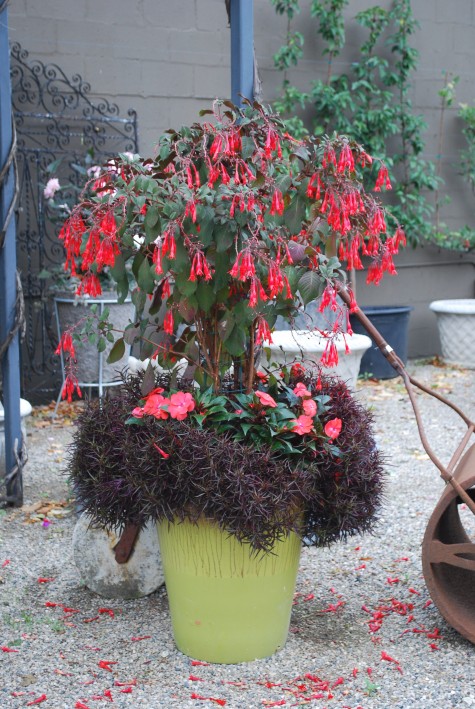 Topiary is the art of pruning, and training a plant to grow in whatever shape you might fancy. Plenty of plant species lend themselves to this kind of treatment. The above pictured lantana is seven years old. It began as a small plant, whose side branches were removed until the primary trunk was about four feet tall. A devoted grower then pinched back the main leader-the first step in the formation of the top. As I like slightly flattened spherical shapes in topiary, we keep the top pruned, and grow the side shoots wide. Lantana flowers profusely in hot weather, it makes a strikingly statuesque topiary plant. In the fall, I cut the head of the plant back by two-thirds,, strip all the remaining leaves off, and stash it in the greenhouse. I strip the leaves off, as lantana is a magnet for whitefly-and they multiply like lightening in a green house environment. What they require is plenty of trouble, but it is glorious in form and flower.
Topiary is the art of pruning, and training a plant to grow in whatever shape you might fancy. Plenty of plant species lend themselves to this kind of treatment. The above pictured lantana is seven years old. It began as a small plant, whose side branches were removed until the primary trunk was about four feet tall. A devoted grower then pinched back the main leader-the first step in the formation of the top. As I like slightly flattened spherical shapes in topiary, we keep the top pruned, and grow the side shoots wide. Lantana flowers profusely in hot weather, it makes a strikingly statuesque topiary plant. In the fall, I cut the head of the plant back by two-thirds,, strip all the remaining leaves off, and stash it in the greenhouse. I strip the leaves off, as lantana is a magnet for whitefly-and they multiply like lightening in a green house environment. What they require is plenty of trouble, but it is glorious in form and flower.
 Well grown large topiary plants are expensive. It takes a lot of time to grow them on-sometimes years go by before a plant can be sold. This dwarf variegated euonymus with a batch of leaves atop a stem tells the story. In ten years, this plant will not be much taller-just much stockier, with a full head of leafy branches. As euonymus is a hardy shrub, they like to be wintered in a cool light place.
Well grown large topiary plants are expensive. It takes a lot of time to grow them on-sometimes years go by before a plant can be sold. This dwarf variegated euonymus with a batch of leaves atop a stem tells the story. In ten years, this plant will not be much taller-just much stockier, with a full head of leafy branches. As euonymus is a hardy shrub, they like to be wintered in a cool light place.
 Bay Laurel is not hardy here, unfortunately-so a greenhouse is a necessity in the winter. This plant is 14 years old. This single ball topiary suckered at the base so persistently, I finally just let it grow. The formal shape is easy to keep up; you can see it needs a little haircut right now. There are many kinds of topiary shears available-I like short bladed snips, so I can cut branches without slicing into the leaves. Any leaf that is cut will show that telltale browing on that cut edge within days. �
Bay Laurel is not hardy here, unfortunately-so a greenhouse is a necessity in the winter. This plant is 14 years old. This single ball topiary suckered at the base so persistently, I finally just let it grow. The formal shape is easy to keep up; you can see it needs a little haircut right now. There are many kinds of topiary shears available-I like short bladed snips, so I can cut branches without slicing into the leaves. Any leaf that is cut will show that telltale browing on that cut edge within days. �

Coleus makes a great topiary, but the growing process is different. As it is a short lived annual plant, they need to be grown fast. Coleus, irisine, geraniums and the like are given a push with a growth hormone. The specific hormone causes the cells of the plant to elongate; the stem develops fast. One crop of 50 tree geraniums I grew 20 years ago got treated five times before they reached their four foot finished height. Topiaries grown from non-woody plants need careful staking of the stem-that stem will never be as strong as a branch. I usually stake with a pair of bamboo stakes, for extra insurance. A beautiful topiary-its head snapped off in a wind- this is enough to make you fall to the ground and weep.

Some woody plants have such a tight habit of growth that you might suspect they were topiaries from the beginning. Dwarf Alberta Spruce is one such tree that lends itself to the pruning process with ease. An Alberta Spruce of this gorgeous shape and size is expensive; many many years has gone into the growing and shaping process. As they are hardy, they can make a big statement as a centerpiece in a formal garden.

Gardenmeister fuchsias are vigorous growers and bloomers; they make an ideal subject for an informally shaped topiary. They are easy to winter over, and bloom continuously from spring to fall. This topiary is supported on the interior by a column of heavy grade wire fencing. Once the multiple stems and flowering shoots grow in, that support fades from view. Big fuchsias make good subjects for topiary in general-but I like the vigor of this particular variety.
 Ivy can be readily be trained over a wire form. This makes it an ideal subject for fast growing. The vines are tied to the form to provide completely coverage, and the vines are clipped as needed. Hedera algeriensis ” Gloire de Marengo”, or variegated Algerian ivy, has large glossy leaves, and a prominent white variegation; old topiaries grown from this plant are striking. A bonus-it is possible to winter ivy topiaries over in the house.
Ivy can be readily be trained over a wire form. This makes it an ideal subject for fast growing. The vines are tied to the form to provide completely coverage, and the vines are clipped as needed. Hedera algeriensis ” Gloire de Marengo”, or variegated Algerian ivy, has large glossy leaves, and a prominent white variegation; old topiaries grown from this plant are striking. A bonus-it is possible to winter ivy topiaries over in the house.
 The coleus topiary I let go after two seasons-they seem to loose vigor. The minute you decide to grow a plant in any form which is not its natural form, there will be maintenance problems down the road. Plants tolerate being fooled with by people-they rarely love it. Plants that naturally lend themselves to this treatment are easier to look after.
The coleus topiary I let go after two seasons-they seem to loose vigor. The minute you decide to grow a plant in any form which is not its natural form, there will be maintenance problems down the road. Plants tolerate being fooled with by people-they rarely love it. Plants that naturally lend themselves to this treatment are easier to look after.

For all their trouble, a well grown topiary plant can instantly provide large scale to a new planting. Handsome, this. Should you be the patient sort, try growing one of your own. Lacking patience, the nursery industry offers many different species of trained to shape plants. I admire any pair of hands that can make them grow.